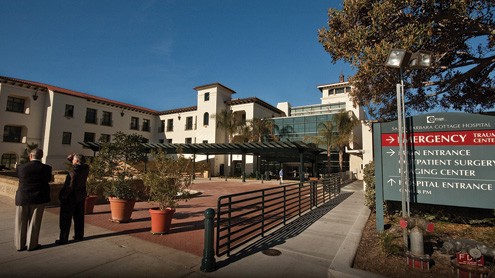Sansum-Cottage deal heads to FTC for review
IN THIS ARTICLE
- Health Care & Life Science Topic
- Marlize van Romburgh Author
By Marlize van Romburgh Friday, November 29th, 2013

Santa Barbara Cottage Hospital is part of Cottage Health System, which plans to merge with Sansum Clinic, a physician network. (Business Times file photo)
The future of health care in South Santa Barbara County became considerably clearer in recent days, with the biggest merger in decades headed off for regulatory review and hiccups in the delivery of care through the state insurance exchange and to the poor largely resolved.
Cottage Health System and Sansum Clinic said their merger is proceeding on track for completion early next year and is under review at the Federal Trade Commission. Sansum, for its part, has smoothed out some contractual sticking points that could have blocked those buying policies on Covered California, the state’s insurance exchange, from accessing its services.
Meanwhile, Santa Barbara Neighborhood Clinics, which provides low-cost care to the poor and serves about 17,000 patients a year, said it plans to expand in Goleta, bouncing back after nearly running out of money earlier this year.
Here’s a closer look at each development.
Merger heads to regulators
The proposed merger between Sansum Clinic and Cottage Health System would combine two nonprofit health providers that each employ thousands of people and see tens of thousands of patients a year.
Cottage spokeswoman Maria Zate said the two groups are moving forward with due diligence, and that the proposed merger has been submitted to the Federal Trade Commission to scrutinize for any potential market concentration issues.
“Based on what we know today, we’re hopeful that an affiliation might be finalized in the early part of 2014,” Zate said in an email.
A spokesperson for the FTC said the agency could not comment. However, health-care consolidation rarely comes under scrutiny from federal regulators — of the hundreds of hospital mergers in the U.S. since 1987, the FTC has challenged only a handful — and the Affordable Care Act encourages partnerships between health groups as a way to achieve greater operational efficiency.
“These kinds of mergers and partnerships are happening all over the state,” Jan Emerson-Shea, a spokeswoman for the California Hospital Association, told the Business Times earlier this year when the Sansum-Cottage deal was announced. “They’re not uncommon and they’re very much driven by the Affordable Care Act. There are financial incentives and financial penalties — for hospitals and clinics and other providers — that call for them to work more closely together.”
Sansum listed on exchange
Sansum said on Nov. 22 that its 23 outpatient medical clinics will serve patients who buy Anthem Blue Cross coverage on the state’s online health insurance exchange. Sansum is one of the largest primary care providers in Covered California’s District 12, which includes Santa Barbara, Ventura and San Luis Obispo counties.
Lack of access to Anthem Blue Cross coverage through the state exchange had created a stumbling block for thousands of eligible people in the region. Indeed, because it did not have agreements with the exchange’s two providers, Anthem Blue Cross or Blue Shield of California, Sansum Clinic was not listed as a member of the network. “It’s a big breakthrough for the community,” Sansum CEO Dr. Kurt Ransohoff told The Business Times in a phone interview. “I have heard from many of my patients that they needed to get new insurance.”
Sansum said in a statement that by early December the Anthem Blue Cross website should list Sansum Clinic as a member of the exchange but said it was not clear when Sansum would be added to the Covered California website.
Ransohoff said Sansum was taking a decrease in its rates in order to join the network, but he also agreed that by being part of the exchange Sansum will be able to attract patients who are able to afford insurance coverage for the first time.
Sansum has not reached an agreement with Blue Shield of California, the other provider of insurance via Covered California. However, it has reach an accord with the University of California to be a Tier 1 provider on its UC Care preferred provider program.
“We’re thrilled to be the only insurer to have Sansum Clinic in our exchange network,” Ernie Schwefler, regional vice president of provider contracting at Anthem Blue Cross said in the statement.
Neighborhood Clinics
In a separate development, the struggling Santa Barbara Neighborhood Clinics nonprofit said Nov. 21 that it is narrowing its funding gap and has a strategic plan and new permanent CEO in place, putting it on track to become financially sustainable at a time when it looks to expand service to Goleta.
“Six months ago, we were in danger of closing our doors,” Mark Palmer, president of the board of the nonprofit, said at a press conference. “I can tell you now that we have weathered that storm.”
SBNC operates three affordable health care clinics and a dental clinic on the South Coast. The nonprofit clinic network provides free or low-cost health care to uninsured and underserved members of the community, and it’s the only organization in the county to do so, excluding clinics that serve exclusively veterans or homeless individuals.
Since kicking off a 100-day plan to regain its financial footing, the organization received $600,000 in donations from a group led by the Santa Barbara Foundation. The funds were tied to monthly goals and the implementation of a strategic plan.
SBNC said that through a new operation plan, it will gain upwards of $1 million in cost savings per year.
At the same time, the organization recently received a large grant from The Health Resources and Services Administration, a federal agency, to open a new clinic in Goleta’s Old Town neighborhood. The funds are part of a Medicaid expansion under the Affordable Care Act and include an immediate grant of $812,500 plus annual funding of $650,000 starting in 2014. The nonprofit is currently looking for a facility of about 11,000 square feet to house the new clinic.
Palmer said SBNC has been able to make “a really positive transition” as a result of generous community support, combined with a new operating plan.
Trula Breuninger, who was brought in as interim CEO this summer, now holds that position on a permanent basis. She has previously served as CEO for community health care organizations including the San Diego American Indian Health Center and, most recently, the Southern Indian Health Council in Alpine, Calif. Breuninger received her MBA from the W.P. Carey School of Business at Arizona State University and a master’s degree in public health from UC Berkeley.
SBNC, which in May said it was in danger of closing its doors due to a funding crisis, said Nov. 21 that its new operational plan has allowed it to bring its monthly deficit down to $100,000 a month from $250,000.
Long-term, the group expects its funding gap to be about $75,000 a month or $800,000 a year, Palmer said. The deficit — the difference between the group’s operating revenues and its expenses — is the amount SBNC seeks in community support.
Breuninger said the group was able to cut costs in part by outsourcing some positions. SBNC had 103 staff positions when she started, she said; it now has 94.
SBNC said its turnaround comes at the same time that it is experiencing record demand for low-cost primary care. In October, the group’s clinics experienced record patient visits, with 5,187 people turning to the nonprofit for free or low-cost health care. SBNC’s dental clinic saw about 1,500 people, up from its usual monthly figure of 1,000 to 1,200 patients, executives said.
The clinics have served about 17,000 patients a year. About one-third of those patients are non-reimbursable, with SBNC receiving little or no revenue from either patients or the government.
Breuninger said the group believes that higher government reimbursement rates will kick in as a result of the clinics implementing electronic medical records. The organization also believes that with health care reform, many patients who had previously been ineligible for government funds will now become eligible, also resulting in more revenue for the clinics.
Cottage Health System paid for a consultant to help the Neighborhood Clinics devise a workable business model.
Zate, the Cottage spokesperson, said the low-cost clinics are an important part of the South Coast’s health-care industry. “The SBNC clinic setting is the appropriate place for many patients to receive primary care and is more cost-effective for the community than using a hospital emergency department for non-emergent care,” she said. “Having a medical home, with access to primary care providers, is important for improving the health of the underserved in our community.”
[EDITOR’S NOTE: A previous version of this article misstated 17,000 as the number of patient visits per year that Santa Barbara Neighborhood Clinics averages. The group serves about 17,000 patients per year.]










